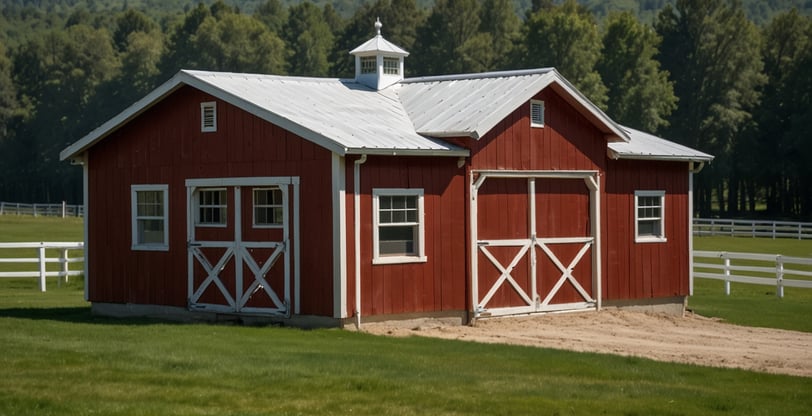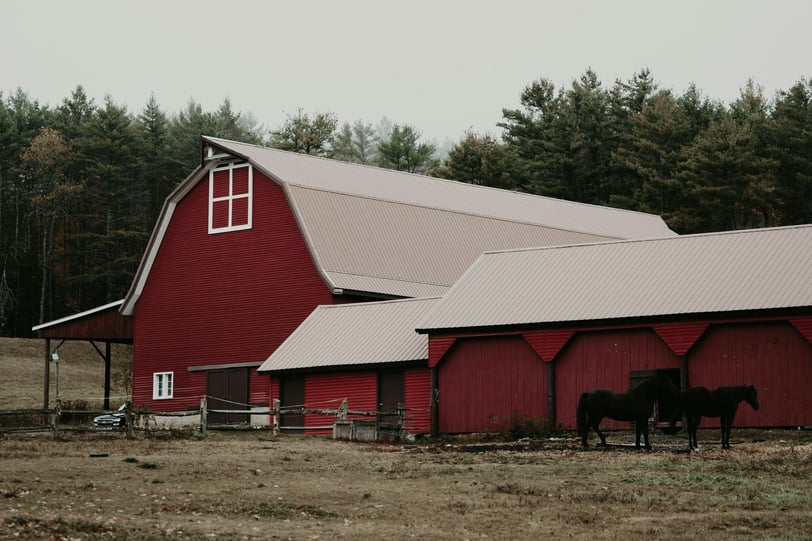Creating Safe and Comfortable Horse Barns
Discover the essentials of designing horse barns with this ultimate guide. Learn about barn styles, materials, features, and maintenance tips to create a safe and functional space for your horses.


Horse barns are more than just a place to shelter your equine companions; they are a crucial aspect of horse care and management. A well-designed barn ensures the safety, comfort, and health of your horses while enhancing your property’s functionality and value. Whether you’re building your first barn or upgrading an existing one, this guide will help you create the ideal horse barn. Learn more in depth on how to build a horse barn.
Understanding the Basics of Horse Barns
Before diving into the design process, it’s essential to understand the purpose and requirements of a horse barn. Horse barns are structured to provide:
Shelter from Weather: Protecting horses from extreme temperatures, wind, and precipitation.
Safety and Security: Preventing injuries and keeping horses safe from predators.
Convenience for Caretakers: Streamlining feeding, grooming, and cleaning routines.
Space for Socialization: Allowing horses to interact safely.
By focusing on these elements, you can ensure your horse barn is both functional and comfortable for your animals.
Key Features to Include in Horse Barns
A great horse barn balances practicality with aesthetics. Here are some essential features to include:
Stalls:
The size of the stalls matters; a 12’ x 12’ stall is ideal for most horses. Larger breeds may require more space.
Ensure proper ventilation to prevent respiratory issues.
Aisleways:
Wide aisleways (at least 10 feet) allow for easy movement of horses and equipment.
Consider non-slip flooring for added safety.
Ventilation:
Proper airflow is essential to reduce odors and moisture.
Install ridge vents, windows, and fans to keep the barn fresh.
Lighting:
Natural light is preferable, so incorporate windows and skylights.
Use energy-efficient LED lighting for nighttime visibility.
Tack Room:
Design a secure and organized space for storing saddles, bridles, and other equipment.
Include shelves, hooks, and climate control to protect your gear.
Wash Bays:
Install a designated area with proper drainage for grooming and bathing horses.
Include hot and cold water options for added convenience.
Types of Horse Barns
When it comes to barn styles, there are several options to suit different needs and budgets. Here are some popular types of horse barns:
Center Aisle Barns:
These barns feature a central aisle with stalls on either side.
They offer excellent ventilation and easy access to each stall.
Shed Row Barns:
A single row of stalls with an overhang for weather protection.
Ideal for small properties or warm climates.
Modular Barns:
Prefabricated sections that can be assembled quickly.
Cost-effective and customizable.
Monitor Barns:
Known for their raised center aisle roof, which improves ventilation and lighting.
Stylish and functional, these barns are popular among horse owners.
Run-In Sheds:
Open-sided shelters that allow horses to come and go as they please.
Best suited for pastured horses.
Materials for Building Horse Barns
Choosing the right materials is critical for durability and safety. Here’s a breakdown of common materials:
Wood:
A classic choice, wood provides a natural look and good insulation.
Requires regular maintenance to prevent rot and pests.
Metal:
Durable and low-maintenance, metal barns are resistant to fire and pests.
May require insulation to regulate temperature.
Concrete:
Often used for flooring and walls due to its strength and ease of cleaning.
Can be harsh on horses’ legs without proper bedding.
Composite Materials:
A blend of wood and plastic, offering durability and reduced maintenance.


Horse Barn Design Tips for Comfort and Efficiency
Designing a horse barn involves more than just selecting materials and features. Consider these tips to create a functional and comfortable space:
Site Selection:
Choose a location with good drainage to prevent water accumulation.
Ensure easy access to utilities like water and electricity.
Orientation:
Position the barn to take advantage of natural light and prevailing winds.
Avoid placing the barn in low-lying areas prone to flooding.
Flooring:
Use materials like rubber mats or packed gravel for safety and comfort.
Avoid slippery surfaces that can lead to injuries.
Bedding:
Provide ample bedding, such as straw or wood shavings, to keep stalls clean and dry.
Regularly remove soiled bedding to maintain hygiene.
Manure Management:
Establish a plan for storing and disposing of manure to keep the barn area clean.
Composting is an eco-friendly option.
Budgeting for Horse Barns
Building a horse barn is a significant investment. Costs can vary widely depending on size, materials, and features. Here’s a rough estimate of expenses:
Basic Barns: $20,000 – $50,000
Mid-Range Barns: $50,000 – $100,000
Luxury Barns: $100,000 and up
To save money, consider:
DIY construction for simple designs.
Using prefabricated kits.
Prioritizing must-have features and adding extras later.
Maintaining Your Horse Barn
Regular maintenance ensures your barn remains safe and functional for years to come. Key tasks include:
Inspecting the Structure: Look for signs of wear, such as loose boards or rusted metal.
Cleaning Stalls: Remove manure and wet bedding daily.
Checking Ventilation: Clean vents and fans to maintain airflow.
Repairing Fences: Ensure all enclosures are secure and in good condition.
Pest Control: Use humane methods to prevent rodents and insects from inhabiting the barn.
Enhancing Your Property with Horse Barns
A thoughtfully designed horse barn adds value to your property. It reflects your commitment to horse care and creates a welcoming environment for your equine companions. Whether you’re a recreational rider or a professional trainer, investing in a quality barn is a decision that pays off in countless ways. Ready to get started? Dive into this detailed resource on creating a horse barn that meets your specific needs, from choosing materials to designing the perfect layout, ensuring a safe and functional environment for your horses.
By incorporating the right features, materials, and design elements, you can create a horse barn that meets your needs while providing a safe and comfortable space for your horses. Start planning today and enjoy the benefits of a well-designed barn for years to come.
